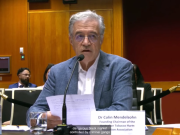Maximum exposure levels to e-vapor, still not solved, and for good reasons

The e-cigarette specialist evokes the complexity of setting up norms on exposure levels because all the work that has been done to date regards the safety in working places where the user is exposed at 100% for 8 hours/day. In contrast, exposure to e-cigarette vapor is intermittent and will be proportional to the amount of e-liquid consumed by the user. A value that can differ significantly from one user to another or, for the same person, from one day to the other and is far from occupational health standards.
K. Farsalinos and his co-authors circumvented most of the problems by reducing occupational norms to daily exposure limits but remains the issue of ifluctuating volumes consumed, which can only be solved if vapers become aware of dangerous drifts in their daily use of the e-cigarette.
 But not all scientists share the same professionalism, as demonstrated by the alarming (again!) headlines of the Mirror as limpid illustration of the above statement that occupational safety levels are not adapted to vaping.
But not all scientists share the same professionalism, as demonstrated by the alarming (again!) headlines of the Mirror as limpid illustration of the above statement that occupational safety levels are not adapted to vaping.
The findings of the US researchers at the origin of the Mirror’s article have been advertised in a press release of their research institute in Reno (NV). Once again, one can just deplore that no comparison is made with the concentration of the same products in cigarette smoke to emhasize the relative risk of vaping to smoking and, in order to infer the “250 times more toxic”, the authors refer to the American Conference of Governmental Industrial Hygienists Threshold Limit Value that are given in reference to occupational and environmental health.
Educating the vaper to seek quality
The researcher told us, at the time the buttery flavor diacetyl made the buzz on the internet, that its presence was avoidable in e-liquids because substitution molecule with a less harmful profile are available. Hence, he was recommending “tolerance zero” on this specific compound.
When questioned on the action that should be taken with respect to diacetyl, K. Farsalinos suggests that more useful than setting up norms, the inclusion of a small leaflet with the e-liquid to explain the visual warnings in a few words and give details on the quality of the manufacturing process would serve as an educational tool for the consumer. The educated consumer will seek the presence of this leaflet when purchasing another juice of another brand and question the transparency of manufacturing process if absent.
According to the researcher, it is the unique way to switch from a consumer behavior centred on “price and taste”, what reflects the actual market enquiries, to a more responsible behavior turned to quality and safety.
Education, initiated by e-juice manufacturers
“Every brand makes the best e-liquid“, he notices with a touch of irony, “but only few of them give us the prove of it“. For the author of what is now considered a reference book on analytical assessment of e-cigarettes, transparency in the results of e-juices testings should be the norm among manufacturers. The cost of an analysis by an independent laboratory is less than €100, in most cases, and it comes back with a certificate indicating the references of the e-liquid. No need to test all the bottles, only a test of the flavoring concentrate is mandated, since this one will be diluted in an organic base of PG and VG.
When the consumer becomes interested in the quality of his/her product, he/she can easily identify the juice through its ID and download the analysis certificate on the manufacturer’s website. With time, K. Farsalinos hopes that the quality concern will guide the user in his/her choice rather than price. Hence, the efforts made in research to improve vaping safety will be echoed by good practices, on the user’s side.

Prof Riccardo Polosa, also present at the French the e-cigarette symposium, shares with K. Farsalinos the opinion that a need for educating vapers becomes necessary to move on with scientific aspects. A Vaping Post and ECigIntelligence survey of vapers’ behaviors revealed that atomizer’s maintenance frequency was concerning for a majority of experimented users, although it is the first and immediate action to guaranty the best quality of emissions.












Vapers is an effective way of quitting the habit of smoking but it takes a good quality e-juice to prove the safety of vaping. http://www.levelvape.com/